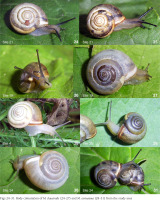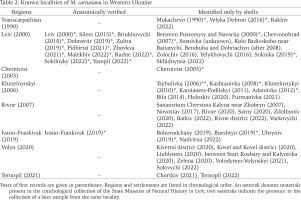INTRODUCTION
Three species of the genus Monacha Fitzinger, 1833 are known in Ukraine (Balashov 2016). All of them have been discovered as introduced species in Lviv and its immediate environs. Monacha fruticola (Krynicki, 1833) is of Crimean origin, but is now often found in the south of Ukraine outside the Crimean peninsula (Gural-Sverlova 2018, Gural-Sverlova et al. 2018). Most of the known records were made from the Odessa region in the west to the Zaporizhzhia region in the east (Gural-Sverlova & Gural 2020: fig. 2). Outside the Crimea, M. fruticola was first mentioned by Schileyko (1978) for Odessa and its environs (collected in 1959) as an introduced species. Recently, M. fruticola was first found in Western Ukraine: in 2018 near Lviv (Briukhovychi), and in 2019 in Lviv itself (Gural-Sverlova & Gural 2020). In 2020–2022 similar records were also made in Central Ukraine, in Kyiv and its immediate environs (Balashov & Markova 2023).
Monacha cartusiana (O. F. Müller, 1774) until almost the very end of the 20th century was mentioned only for the south of Ukraine (Schileyko 1978). Now this species is increasingly recorded even in the most northern regions of Ukraine (iNaturalist 2022, UkrBIN 2022, Balashov & Markova 2023). In Western Ukraine, M. cartusiana was first found in 1990 near Mukachevo, Transcarpathian region, and since 2000 it has been known for Lviv and the Lviv region (Gural-Sverlova & Gural 2022a).
The eastern Mediterranean species Monacha claustralis (Rossmässler, 1834) was first recorded in 2021 at one site in Lviv, where it coexisted with the conchologically identical M. cartusiana (Gural-Sverlova & Gural 2022a). Previously, M. claustralis was known in Ukraine from a single mention for Sevastopol, Crimea (Hausdorf 2000a).
M. claustralis and M. cartusiana, whose species independence has been genetically confirmed (Pieńkowska et al. 2015, 2016, 2018), are complete conchological twins, distinguishable only anatomically (Hausdorf 2000a, Pieńkowska et al. 2015). Moreover, both species have a fairly similar structure of the distal genitalia (Pieńkowska et al. 2015), so for a long time they were considered one species, M. cartusiana. The main differentiating feature is the presence of a lateral sac (sac-like diverticulum) on the vagina in M. cartusiana, which was first noticed by Giusti & Manganelli (1987). M. claustralis does not have such a sac, and the vagina has a more elongated and slender shape (Hausdorf 2000a, Pieńkowska et al. 2015).
As an additional identifying feature, the internal structure of the atrium can be used. According to Pieńkowska et al. (2015), atrium “internally rather smooth or with thin, low pleats in M. cartusiana vs with sort of wide, spongy, slightly raised pleat separating penis from vaginal appendix in M. claustralis”. Our preliminary studies in Western Ukraine (Gural-Sverlova & Gural 2022a) showed that the use of this additional feature is particularly useful during the identification of M. cartusiana specimens that have an atypically long and slender vagina with a slight, sometimes poorly visible lateral sac.
Preliminary analysis (Gural-Sverlova & Gural 2022a) showed that in the area of our study, the length of the vagina or the shape and proportions of the vaginal appendage (Pieńkowska et al. 2015) cannot be used to differentiate between M. cartusiana and M. claustralis. In Lviv and its environs, the vagina length in M. cartusiana varies greatly and partially overlaps with that in M. claustralis (Gural-Sverlova & Gural 2022a: table 1). Therefore, this feature could be useful in identifying populations rather than individual specimens. It is especially problematic to use when two species live together. The vaginal appendage in both species turned out to be identical there, distinctly differentiated into a wider and shorter basal part and a narrower and longer apical part (Gural-Sverlova & Gural 2022a: figs 2–3). Similar appendages in both species are shown in Hausdorf (2000a, b).
Table 1
Anatomically studied samples of M. cartusiana (CAR) and M. claustralis (CLA) from Lviv and its immediate environs
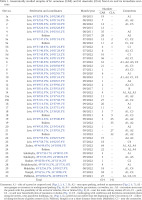
Until the recent discovery of M. claustralis in Western Ukraine (see above), M. cartusiana was easily distinguished conchologically from all other land snail species, native or introduced, known to this area. Therefore, it was believed that a reliable identification of M. cartusiana was possible here without studying the genitalia, on the basis of collected empty shells, or even photographs taken by amateur naturalists (iNaturalist 2022, UkrBIN 2022). This led to the accumulation of a significant amount of data about the spreading of M. cartusiana in Western Ukraine, not confirmed anatomically (Gural-Sverlova & Gural 2022a). In particular, this applies to Lviv and its immediate environs, where M. cartusiana has recently become an increasingly common species.
Therefore, the main goal of our study was to assess how different species of Monacha, especially M. claustralis and M. cartusiana, are currently distributed in Lviv and its environs, as well as what factors can contribute to the rapid spread of M. cartusiana observed now in different parts of Ukraine. In addition, we wanted to analyze the data on the findings of M. cartusiana in Ukraine accumulated at present, as well as the chronology of its records in the western administrative regions and other parts of the country.
MATERIAL AND METHODS
We anatomically examined adult specimens of the genus Monacha collected from 2011 to 2022 at 33 sites of Lviv and its immediate environs: Briukhovychi, Malekhiv, Pidbirtsi, Rudne, Sokilnyky, Yampil, Zubra (Fig. 1). Some of the studied habitats are shown in Figures 2–9. Two sites in Lviv and Briukhovychi where M. fruticola was found in 2018–2019 are described in a previous publication (Gural-Sverlova & Gural 2020). The geographical coordinates of other sites and the species found there are shown in Table 1. In the same table, capital letters indicate some features of the studied sites that could contribute to the appearance of populations or single individuals of M. cartusiana or M. claustralis: A – connection with road transport, B – the only site near the main railway station of Lviv, C – sites where the appearance of Monacha or other introduced land molluscs could be associated with ornamental or garden plants.
Fig. 1
Locations of the studied sites in Lviv and its immediate environs, where M. fruticola (grey circles), M. cartusiana (red), M. claustralis (green), M. cartusiana and M. claustralis together (blue) were found. Sites 1 to 31 are numbered as in Table 1, followed by M. fruticola localities in Lviv (32) and Briukhovychi (33)
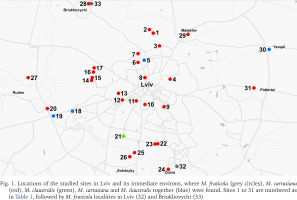
Figs 2–9
Habitats where only M. claustralis (2), M. claustralis and M. cartusiana together (3–5), only M. cartusiana (6–9) were found. Red crosses indicate the places where snails were collected
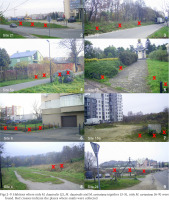
Two anatomical features were used to differentiate M. cartusiana and M. claustralis: the presence or absence of a lateral sac on the vagina and the internal structure of the atrium (see Introduction for more details).
Although the cryptic species M. cartusiana and M. claustralis cannot be distinguished by the appearance of the snails, in some areas the body colouration of different species may differ slightly (Pieńkowska et al. 2015). To find out whether there are such local differences in Lviv and its environs, in October 2022, the colouration of snails was studied in three samples from sites where only M. claustralis (site 21), only M. cartusiana (site 24), or both species together (site 19) were recorded. In the latter case, only specimens of M. claustralis were present in the October sample (Table 1). Previous photographs of live specimens of M. cartusiana from Lviv (site 4) and Malekhiv (site 29) were also studied.
To map the known records of M. cartusiana in Ukraine, as well as to analyse the chronology of the discovery of this species in different administrative regions in the west of the country, we used our own long-term observations, conchological materials stored in the malacological collection of the State Museum of Natural History in Lviv, some literature data (e.g. Retowski 1883, Pusanov 1925, 1926, 1927, Sverlova et al. 2006, Balashov et al. 2013, 2018, Rybka 2017, Gensytskyi 2021, Balashov & Markova 2023) and photographically confirmed observations from two citizen science databases (iNaturalist 2022, UkrBIN 2022). iNaturalist is a joint initiative by the California Academy of Sciences and the National Geographic Society. Currently, it brings together more than a million scientists and naturalists from around the world. UkrBIN (Ukrainian Biodiversity Information Network) is a web project and application documenting biodiversity, launched in cooperation with the Schmalhausen Institute of Zoology of National Academy of Sciences of Ukraine (Kyiv).
RESULTS
M. cartusiana was most common in the study area. Of the 33 sites shown in Fig. 1, M. fruticola was found in two. Both findings are described in more detail in a previous publication (Gural-Sverlova & Gural 2020). At 26 sites, only M. cartusiana was recorded, and at one site in the southern part of Lviv, only M. claustralis. In the remaining four cases, cohabitation of M. claustralis and M. cartusiana was revealed, with M. cartusiana prevailing at sites 5 and 30, and M. claustralis predominating at sites 18 and 19 (Table 1).
The distal genitalia of M. claustralis from four sites, where this species was additionally found in 2022, are shown in Figs 10–13. Similar images for several specimens from site 18, where M. claustralis was first found in Western Ukraine in 2021, are available in a previous publication (Gural-Sverlova & Gural 2022a). In all cases, the absence of the lateral sac of the vagina was accompanied by the presence of a fold in the atrium characteristic of M. claustralis (Figs 14–15), which was more or less pronounced. The variability of the vagina shape in M. cartusiana (Figs 16–19) and M. claustralis (Figs 20–23) is shown for two sites where only one of these species was found.
Figs 10–13
Distal genitalia of M. claustralis from Lviv (10–12) and Yampil (13): 10 – site 21; 11 – site 19; 12 – site 5a; 13 – site 30. Abbreviations: at – atrium; ep –epiphallus; fl – flagellum; mg – mucus glands; pe – penis; pl – pleat inside the atrium; va – vagina; vap-1 – basal part of vaginal appendage; vap-2 – apical part of vaginal appendage. Scale bars 1 mm
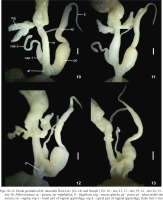
Figs 14–15
Dissected atrium of one specimen from site 21. The arrows show the pleat characteristic of M. claustralis. Scale bars 1 mm
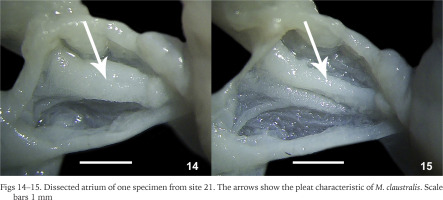
Figs 16–23
Variability of the vagina shape from habitats where only M. cartusiana (16–19, Zubra, site 24) or only M. claustralis (20–23, Lviv, site 21) was found. The arrows show the lateral sac. Scale bars 1 mm
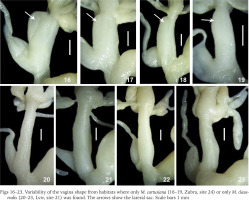
In general, no pattern was found in the spatial distribution of sites where M. claustralis was found (Fig. 1). The only exception is a pair of sites 18 and 19, located relatively close to each other in the west of Lviv. Horodotska Street, which is one of the largest streets in the city with busy car traffic, passes near both sites. At site 5, a few specimens of M. claustralis were found only near mansions (5a and 5b in Table 1) located on Petro Sheremeta Street, which wedged into the park named after the 700th anniversary of Lviv (Fig. 4). In the samples collected at a greater distance from mansions (5c–5e in Table 1), only M. cartusiana was present.
At site 1, where M. cartusiana was first found in Lviv in 2000, and at site 4, where we have known the population of this species since 2011, only M. cartusiana was found in different years (Table 1). At sites 2 and 3, where the appearance of Monacha was clearly related to the initially inhabited site 1, only M. cartusiana was also found.
In most cases, we found M. cartusiana and/or M. claustralis at sites where the appearance of these species could be associated with road transport (indicated by letter A in Table 1). Most often, it is about habitats located along roadsides, where cars can stop for a short time, and with open-air parking lots, ordered or spontaneous. Nearly half of the sites were marked as such, where snails could have entered along with ornamental or garden plants planted along the streets, in household plots, in cemeteries, as well as directly from garden centres where such plants are grown and sold (indicated by the letter C in Table 1).
When snails were collected at the same site in different years or in different months of the same year, this did not significantly affect the presence and ratio of M. claustralis and M. cartusiana in the samples (Table 1). However, in 2022, the following trend was noted. At sites where only M. cartusiana was present or this species predominated, a large number of adults were observed already in late July – early August. By October, the number of live adult snails decreased noticeably. At site 19, where M. claustralis predominated, and at site 21, where only this species was found, even at the end of September there were many fairly large snails that had not yet reached maturity, and in the second half of October there were many live adults.
The body colouration of both M. claustralis (Figs 24–27) and M. cartusiana (Figs 28–31) varied greatly in the study area. When viewing photographs of live specimens of M. cartusiana collected in different years at site 4 (the second population of this species recorded in Lviv, has been known to us since 2011), we paid attention to the light colouration of the body, including the tentacles (Fig. 28). This was especially noticeable in comparison with specimens of M. claustralis from site 21 (Figs 24–25), which had dark gray, almost black tentacles. The majority of individuals from the sample of M. claustralis from site 19 had a similar colouration (Fig. 26). However, several weaker pigmented snails were found at the same site (Fig. 27), and after dissection they were also assigned to M. claustralis. Similarly, both light (Fig. 30) and dark coloured (Fig. 31) specimens of M. cartusiana were collected at site 24 in Zubra.
Using different sources of information (see Material and Methods), we summarised and graphically presented (Fig. 32) the data on the records of M. cartusiana in Ukraine. This shows that this species is currently distributed not only in the south of Ukraine with Crimea, but also in the east and in the centre of the country, in the latter case with the highest concentration of known findings in and around Kyiv. M. cartusiana was also recorded in all 8 administrative regions traditionally attributed to Western Ukraine (Table 2, Fig. 32). To date, the largest number of localities of this species has been registered here in the Lviv region, somewhat less in the Volyn (mainly in the area of Kovel), Rivne and Khmelnytskyi regions. Only one of the known findings of M. cartusiana in Western Ukraine was made before 2000 (Mukachevo), and many date back to the last few years (Table 2).
Fig. 32
Known records of M. cartusiana in Ukraine: blue circles – anatomically verified by the authors; green ones – shells stored in the malacological collection of the State Museum of Natural History in Lviv; red ones – other data (see Material and Methods). All findings in and near Lviv described in this article are shown with a single blue circle
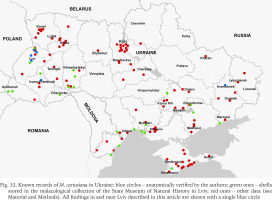
DISCUSSION
M. cartusiana is a sub-Mediterranean species whose present range has been greatly expanded by anthropochory (Kurek & Najberek 2009, Peltanová et al. 2012). In particular, this applies to Central Europe (Oschman 2003, Langner 2003, Lesicki & Koralewska-Batura 2007, Peltanová et al. 2012, Wiese 2014, Hrdlička & Legátová 2023) and Eastern Europe (Zemoglyadchuk 2020, iNaturalist 2022, Balashov & Markova 2023), including Ukraine (Sverlova et al. 2006, Gural-Sverlova & Gural 2022a, Balashov & Markova 2023). For the south of Ukraine with the Crimea, M. cartusiana was often mentioned as a native species (Kurek & Najberek 2009, Balashov & Gural-Sverlova 2012, Balashov 2016), although this species is absent in the review of the Pleistocene malacofauna of Ukraine made by Kunitsa (1974).
In the literature, M. cartusiana has been mentioned for the southern (mountainous) part of Crimea since the second half of the 19th century (Retowski 1883), and for the south of Ukraine outside the Crimean peninsula since the middle of the 20th century (Likharev & Rammelmeyer 1952). However, even now M. cartusiana occurs mainly in anthropogenic rather than natural coastal habitats of the southern Crimea (Balashov & Markova 2023), which may indicate that this species is alien here. According to published data (Gural-Sverlova et al. 2018, Gensytskyi 2021), in the eastern Zaporizhzhia region (Southern Ukraine), which Balashov & Markova (2023: fig. 2) include in the zone of “continuous distribution” of M. cartusiana, this species is found now sporadically and much less frequently than M. fruticola, which was brought here by people from the Crimea and became one of the most abundant species of land molluscs.
It is difficult to establish the time of M. cartusiana appearance in Eastern Ukraine, since the land mollusc fauna of the Donetsk and Luhansk regions remained almost completely unexplored until the beginning of the 21st century (Gural-Sverlova et al. 2012). The earliest sample of M. cartusiana from there, stored at the State Museum of Natural History in Lviv, is dated 1992 and collected on the roadside on the outskirt of Svitlodarsk, Donetsk region. In Western Ukraine, M. cartusiana was first recorded at about the same time (Table 2). It is significant that M. cartusiana was initially discovered in the Transcarpathian lowland (Mukachevo), which has the warmest and mildest climate in this area. Then this species was found in Lviv, the largest city of Western Ukraine, which has intensive transport and trade links with other parts of the country. As expected, the largest number of introduced species of land molluscs in Western Ukraine is now known for Lviv and its environs, a slightly smaller number for the Transcarpathian region (Gural-Sverlova & Gural 2021a).
The range of M. cartusiana has recently expanded northward both in Western Ukraine (Gural-Sverlova & Gural 2022a) and in the central part of the country (Balashov & Markova 2023). The northernmost known records of this species in Ukraine were made in the Rivne (Sarny) and Volyn (Kovel and its environs) regions in the northwest of the country (Fig. 32). Recently, some findings of M. cartusiana have also been made in Brest (Zemoglyadchuk 2020) and the Brest region of Belarus (iNaturalist 2022, Balashov & Markova 2023), adjacent to these regions from the north.
A significant expansion of the range of M. cartusiana has been observed in recent decades not only in Ukraine, but also in some Central European countries, such as the Czech Republic (Peltanová et al. 2012) or in the east of Germany (Langner 2003). This rapid spreading has been attributed to several factors: ecological (climate change), ethological (potential of passive dispersal) and economic (increasing traffic) (Peltanová et al. 2012).
Global warming, combined with the specific microclimate of urbanised areas, has created favourable conditions for the successful survival of some heat-loving species of land snails reliably recorded in Western Ukraine not earlier than the end of the 20th or the beginning of the 21st century (Gural-Sverlova & Gural 2021a: table 2). Among such snails, one can distinguish species of Mediterranean origin, which, in addition to M. cartusiana and M. claustralis, also include Cornu aspersum (O. F. Müller, 1774), Helicidae. At the same time, several populations of two species, which are considered Crimean endemics, but now widely distributed in the south of Ukraine outside the Crimean peninsula, appeared in Western Ukraine (Gural-Sverlova 2018): M. fruticola (Gural-Sverlova & Gural 2020) and Brephulopsis cylindrica (Menke, 1828), Enidae (Sverlova 1998, Balashov et al. 2018). It is significant that a few populations of M. cartusiana and B. cylindrica have already been recorded here outside settlements (Balashov et al. 2018, Gural-Sverlova & Gural 2022a).
The passive dispersal of M. cartusiana, which leads to the transfer of some specimens over more or less large distances and is now often observed outside the natural range of this species, is in most cases associated with human activities. As examples of the natural spreading of M. cartusiana along rivers, their possible transport by water (Oschman 2003) or by birds (Groh & Jungbluth 1993) has been mentioned. In Central Europe, new localities of M. cartusiana are often found near roads, railways and stations (Oschman 2003, Kwitt & Patzner 2017, Hrdlička & Legátová 2023), which leads to a reasonable conclusion about the crucial role of rail and road transport in expanding the range of this species (Oschman 2003). Snails can be found in transported cargo, especially agricultural (Mienis & Waisman 2010), or on containers with them (Peltanová et al. 2012), as well as attached directly to vehicles. Two cases of long-distance transportation of M. cartusiana individuals attached to cars are described. In Germany, three snails covered a distance of about 500 km in this way (Trautner 2000). One specimen of M. cartusiana was brought from the Crimea to Poland, covering three times the distance. Then snail retrieved was kept in a container, where juveniles were seen a month later (Kurek & Najberek 2009). In France, another introduced species of xerophilous land snails, Xeropicta derbentina (Krynicki, 1836), Geomitridae, has been found attached to cars in supermarket parking lots (Aubry et al 2006).
In Lviv and its environs (Table 1) as well as in other localities of Lviv and Ivano-Frankivsk regions studied by us (Gural-Sverlova & Gural 2022a), the populations of M. cartusiana are also most often found near motorways. We assume that the main role here may be played not by freight transport, but by private passenger cars. Since 2000, when we recorded the first population of M. cartusiana on the outskirts of Lviv, the number of such cars in the city has increased significantly, which has led to a noticeable increase in car traffic and, at the same time, to a shortage of organised parking spaces. As a result, cars are often parked on lawns, vacant lots, and other areas suitable for M. cartusiana or M. claustralis, which have similar ecological preferences.
It should be noted that after the first record of M. cartusiana in Lviv (site 1a), the snails soon spread along the nearby road to the outskirts of the Holosko cemetery (site 2), which is now the main active cemetery in the city. It is possible that visitors’ cars parked on the edge of the cemetery contributed to the further dispersal of the species in different parts of the city. However, repeated independent introductions of M. cartusiana to the study area, both separately and, possibly, together with M. claustralis, are also quite probable. Joint introductions of two related species associated with different garden centres were demonstrated by us recently in Lviv for Cepaea nemoralis (Linnaeus, 1758) and C. hortensis (O. F. Müller, 1774) (Gural-Sverlova & Gural 2021b, 2022b, Gural-Sverlova et al. 2021).
Unfortunately, we did not have the technical ability to directly examine cars, as the researchers mentioned above (Trautner 2000, Aubry et al. 2006, Kurek & Najberek 2009). Thus our assumption about the role of private passenger cars in the rapid dispersal of M. cartusiana over the studied area remains hypothetical, if entirely plausible.
Other means of dispersal of M. cartusiana and M. claustralis in Lviv and its immediate environs are not excluded. For example, penetration into new habitats along with plant seedlings from nurseries and garden centres is typical for introduced land molluscs (Bergey et al. 2014, Gural-Sverlova & Gural 2021b, 2022b). However, even when M. cartusiana (sites 23, 31) or both Monacha species (site 30) were found directly along the fences of garden centres, their habitats were grassy roadsides, which is typical for these species. Their appearance there could also be caused by cars owned by these centres, their employees and clients. A necessary condition for the successful operation of any garden centre is a convenient access road to its territory.
By contrast, all known records of M. fruticola in the western and central parts of Ukraine were made at sites where snails could have arrived with plant seedlings: a botanical garden with plants brought from the Crimea in Kyiv and an abandoned garden in its vicinity (Balashov & Markova 2023), a site near an apartment building with flower beds and ornamental shrubs in Lviv and household plots of mansions in its vicinity (Gural-Sverlova & Gural 2020).
M. claustralis, like M. cartusiana, is generally synanthropic, and will expand its range by anthropochory. It is increasingly recorded in urbanised habitats of Central Europe (Pieńkowska et al. 2015, 2016, 2018). In Poland, this species is even more widespread than M. cartusiana (Pieńkowska et al. 2016). As in Lviv, co-occurrence of the two species has previously been noted for Prague in the Czech Republic and Kielce in Poland (Pieńkowska et al. 2016) as well as in Bosnia and Herzegovina (Pieńkowska et al. 2018: fig. 9).
Before the first record of M. claustralis in Western Ukraine (Gural-Sverlova & Gural 2022a), all findings of snails with a similar shell were automatically attributed to M. cartusiana, so they were not always checked anatomically (Table 2). To an even greater extent, this applies to other parts of Ukraine. In addition to Lviv and its immediate environs (Fig. 1), we anatomically studied M. cartusiana from some other localities of the Lviv region, Ivano-Frankivsk (Gural-Sverlova & Gural 2022a) and Kramatorsk (Donetsk region) in the east of Ukraine (Fig. 32). The monograph by Balashov (2016) mentions several anatomically studied specimens of M. cartusiana from the Crimea. Recently, he also anatomically confirmed the presence of M. cartusiana in Kyiv and Kharkiv (Balashov & Markova 2023).
Despite the above, it can be assumed with a fairly high probability that most of the currently known records of M. cartusiana in Ukraine (Fig. 32) belong to this species, and not to its conchological twin M. claustralis. Even in Lviv, where M. claustralis could have been introduced, for example, from neighbouring Poland (see above), this species is now much less common than M. cartusiana (Fig. 1). Indirectly, this may indicate a later introduction. For the central part of Ukraine, the introduction of M. cartusiana from the south of the country seems more likely, as evidenced, in particular, by the discovery of only this species in Kyiv and surroundings (Balashov & Markova 2023).
Since Lviv is the largest city in Western Ukraine, the appearance of M. claustralis here will contribute both to the further dispersal of this species in the Lviv region and its possible penetration into neighbouring administrative regions. Therefore, in a previous publication (Gural-Sverlova & Gural 2022a), we paid special attention to the variability and reliability of anatomical features recommended by some authors for differentiating M. cartusiana and M. claustralis (Hausdorf 2000a, b, Pieńkowska et al. 2015, see also Introduction).
Given the cases of cohabitation of two closely related species, M. cartusiana and M. claustralis, two questions arise, which only genetic research can answer in the future. First, can hybridisation occur in such sites? Second, could the great variability in the vagina length and shape, as well as in the development degree of the lateral sac, noted in some local populations of M. cartusiana (Gural-Sverlova & Gural 2022a) be at least partly due to this potential hybridisation? Although such variability in M. cartusiana from Lviv and its environs is also present at sites where so far not a single specimen has been found that could be attributed to M. claustralis.
We failed to find such local differences in body colouration (Pieńkowska et al. 2015) that could reliably differentiate M. claustralis and M. cartusiana in the study area. However, to search for new locations of M. claustralis as well as mixed populations of two species in the Lviv region, it can be recommended to pay special attention to snails with very dark tentacles (Figs 24–26). Especially if the predominance of such individuals is accompanied by a relatively late seasonal occurrence of mature snails.

